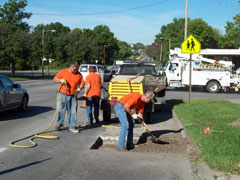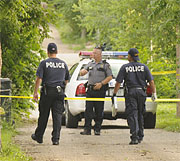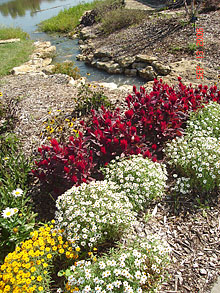In this issue:
- Benefits of Street Projects
- Xeriscaping: Landscaping needing little additional watering
- Lawrence is safer: Advising Federal agencies
Benefits of Street Projects
The warm weather is a mandatory ingredient in maintaining city streets.

Street repairs are necessary because of the damage caused by the winter freeze and thaw cycle. The expanding moisture deteriorates the pavement leading to repairs. Vehicle use also creates the need for maintenance. Over time, a road surface will need repair because of the wear caused by traffic.
The cycle of building a road and then maintaining the surface can be compared to building a home. In the beginning, a new home is not in need of repairs, but preventative maintenance becomes necessary. The inconvenience generated by a construction or maintenance project is usually offset by the better driving surface.
The city appreciates the cooperation of drivers and citizens. The community is asked to be patient when driving through a work zone. Depending on the complexity of the repairs to be made, the length of a project will vary. For example, a road overlay without curb replacement will take less time than an overlay with curbs and driveway access points being replaced.
The volatile factor in a construction project is the weather. The many processes involved in a project all have varying weather requirements. Asphalt cannot be put down unless the temperature is 50 degrees and rising. That means some spring mornings are too cool to begin projects so crews are delayed until later in the day. Following a rain, exposed dirt in a construction project must dry which may take multiple days while a milled surface may be dry in hours. No matter the project, the weather is a large factor in the work schedule.
Xeriscaping: Landscaping needing little additional watering
Xeriscape Principles
- Plan and design for conservation. Plant shade trees to cool the location, reduce wind and conserve energy. Arrange plants into water zones: Low,
medium, high and turf. - Right plant, right place, right zone. Analyze a site for growing conditions.
- Improve soil through use of compost or any other recycled organic matter.
- Use mulch. Apply 2-3 inches of mulch over all beds of shrubs, trees, perennials and annuals. Mulch conserves moisture, keeps out weeds and cools the soil.
- Irrigate efficiently. Most Kansas plants benefit from 1 inch average rainfall each week. Supplemental
watering should be done slowly, deeply and infrequently. Select and combine various irrigation systems such as drips, sprinklers and micro-sprays to suit different plant needs. - Select appropriate drought tolerant grasses. Reduce and maintain
smaller size lawns to
reduce water use areas and irrigation runoff. Substitute wildflowers, ornamental and native grasses in reduced water use areas. - Good maintenance. Pull and remove weeds, prune and fertilize properly, aerate lawns, mow grass high (about 3.5 – 4” high), water targeted plants during drought.
Lawrence is safer: Advising Federal agencies
Fortunately, Lawrence has an extremely low risk of being targeted by an act of terrorism. Unfortunately, today’s realities mean that we have to be prepared for any type of disaster, man-made or natural. You might not think of the probabilities every day, but there are a number of professionals working on emergency response plans.

More than 11,000 agencies have been eligible for Homeland Security funding after September 11, 2001. Each agencies is responsible for selecting the best piece of gear for firefighters, paramedics and police officers.
How does the federal government tackle a task as large as selecting equipment and gear for every first responder agency in the nation? The simple answer is local volunteers. Lawrence Police Chief Ron Olin has served for 10 years on a national committee that plays a big role in helping agencies prepare for emergency responses.
Chief Olin is a member of the InterAgency Board, a committee supporting the Department of Homeland Security, Department of Justice and Department of Defense. He is an active part of a system that uses local officials to advise federal
agencies how to make local communities safer.
Perhaps the most popular piece of work of the IAB is the first responder go-to-guide for selecting equipment. When the leader of any first responder agency, police, fire or medical, has to make the call on which respirator or bullet proof vest, he or she needs to know the best piece of gear is being selected. Research and reviews of each piece of equipment on the market could take months. The standardized equipment recommended for responders can be invaluable for agencies of all sizes. In addition, Chief Olin has helped identify training required at all levels – federal, state, local and tribal – to ensure that the tasks assigned to local agencies can be carried out in a disaster.
Chief Olin is an example of a local agency supplying experience and insight to federal agencies as funding priorities and technology priorities are assigned. This type of national guidance goes a long way to ensure that emergency responders are safe in the future.
For more info on the Interagency Board, visit www.iab.gov.


